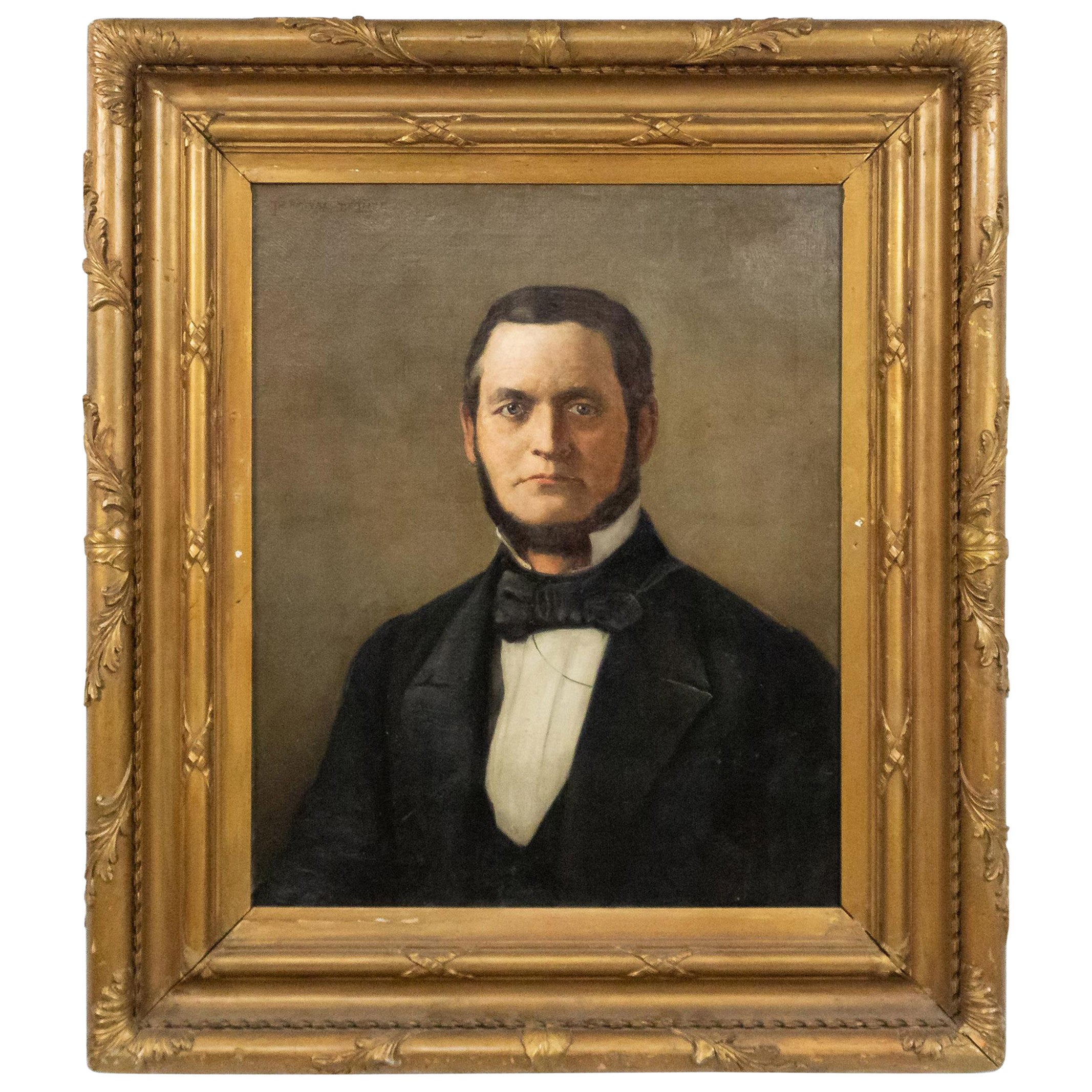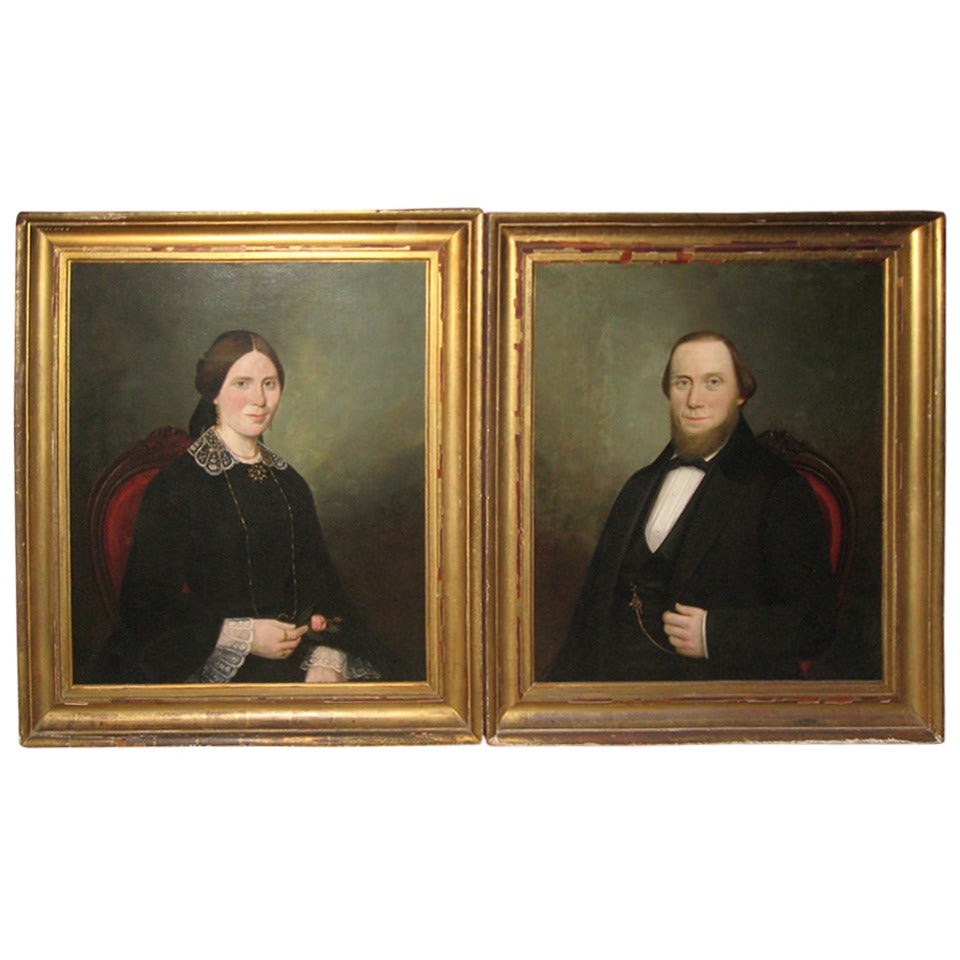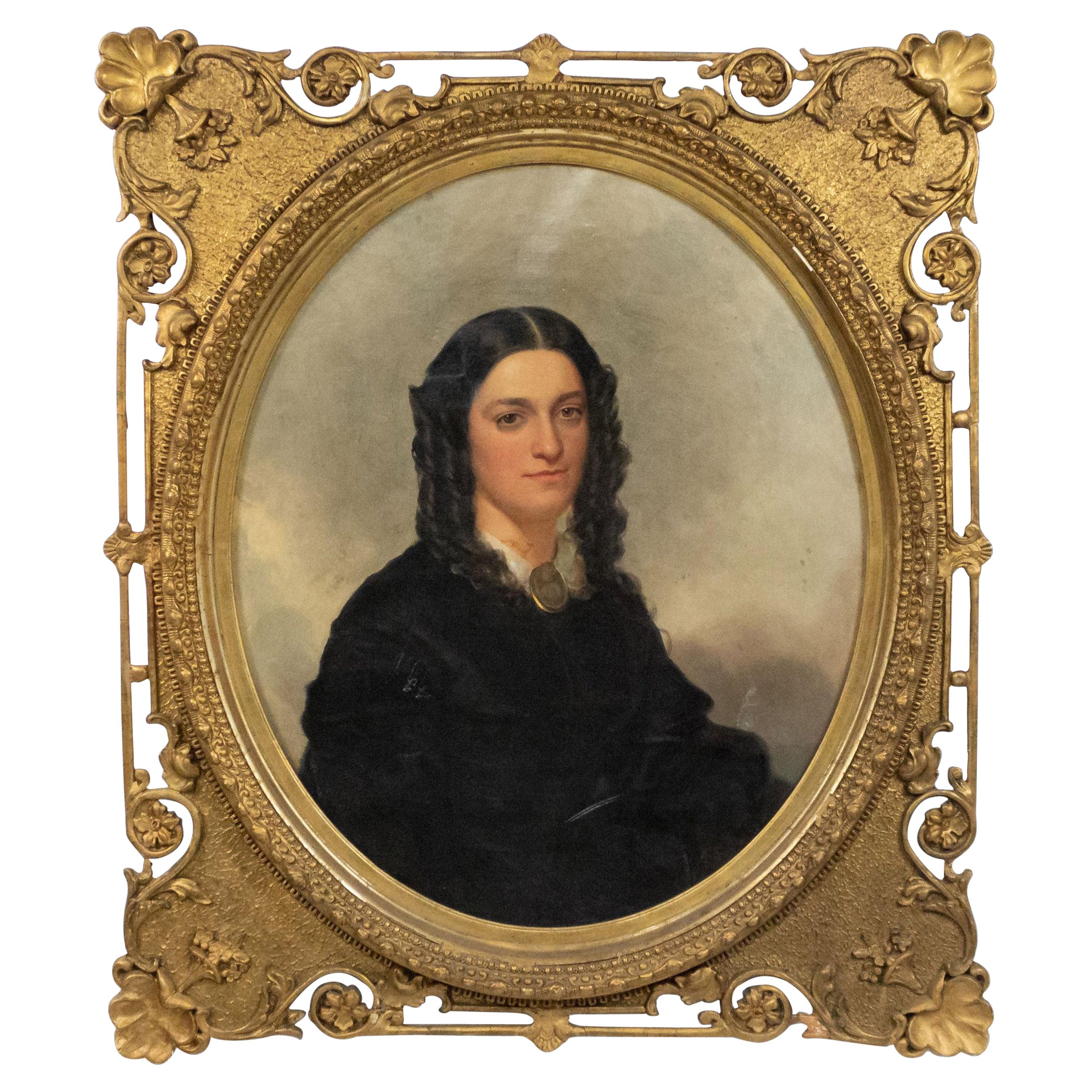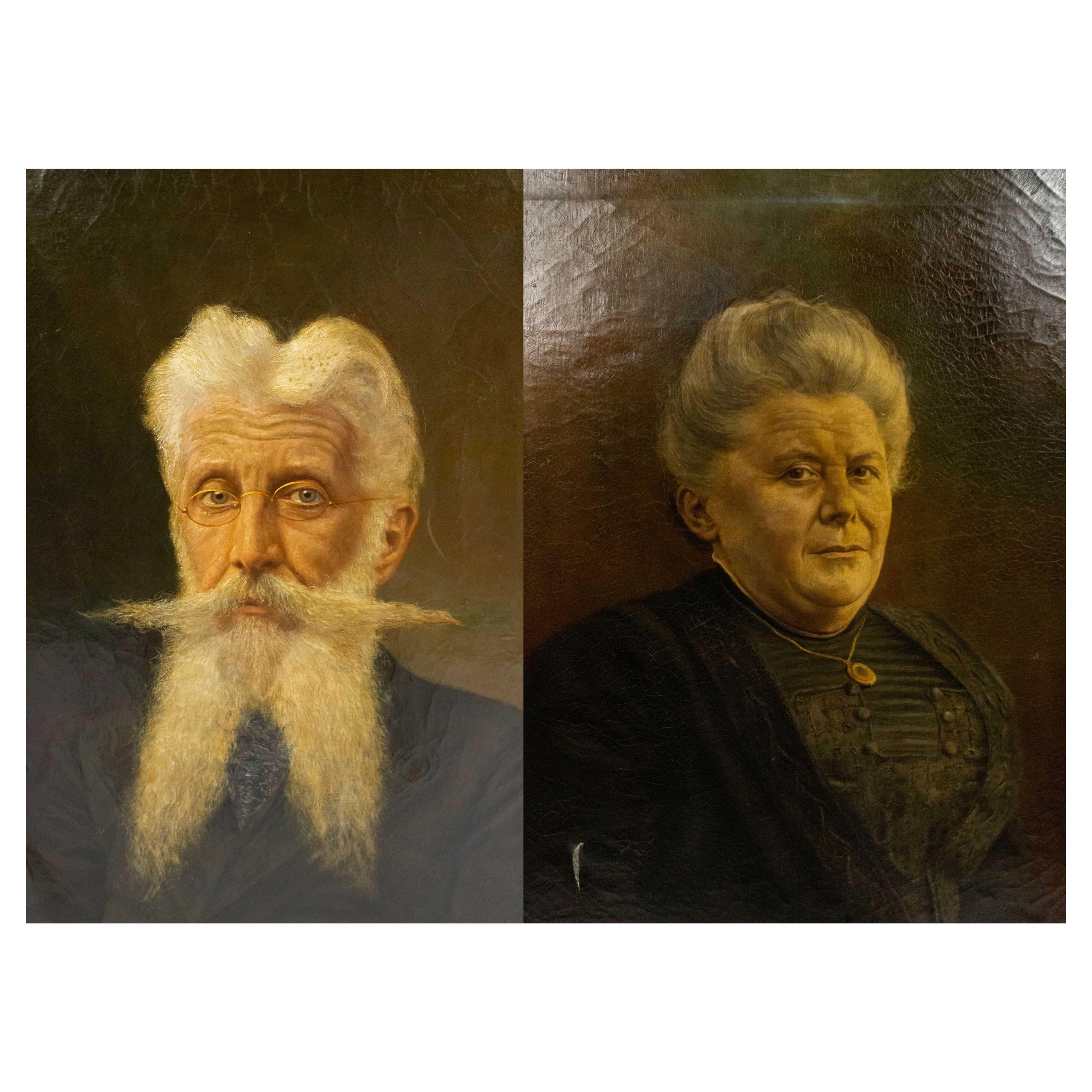Items Similar to 19th c. American Oil Portrait by Oscar Hallwig 1895
Want more images or videos?
Request additional images or videos from the seller
1 of 8
19th c. American Oil Portrait by Oscar Hallwig 1895
About the Item
ABOUT
An antique 19th century oil portrait on canvas of a gentleman. Signed "Oscar Hallwig 1895" on the upper left corner. An original framers label on back.
CREATOR Oscar Hallwig (Maryland, Germany, 1836 -1924)
DATE OF MANUFACTURE c.1895.
MATERIALS AND TECHNIQUES Oil on Canvas. Unframed.
CONDITION Good. Wear consistent with age and use.
DIMENSIONS H 27 in. W 22.25 in. D 1 in.
HISTORY
Unknown.
- Dimensions:Height: 27 in (68.58 cm)Width: 22.25 in (56.52 cm)Depth: 1 in (2.54 cm)
- Style:Victorian (Of the Period)
- Materials and Techniques:
- Period:
- Date of Manufacture:1895
- Condition:Wear consistent with age and use.
- Seller Location:San Francisco, CA
- Reference Number:
About the Seller
5.0
Platinum Seller
These expertly vetted sellers are 1stDibs' most experienced sellers and are rated highest by our customers.
Established in 2014
1stDibs seller since 2015
1,141 sales on 1stDibs
Typical response time: <1 hour
- ShippingRetrieving quote...Ships From: San Francisco, CA
- Return PolicyA return for this item may be initiated within 7 days of delivery.
More From This SellerView All
- American 19th c. Oil Portrait of a Gentleman, c.1800sLocated in San Francisco, CAABOUT A 19th century oil portrait on canvas of a gentleman. Unsigned. CREATOR Unknown. DATE OF MANUFACTURE c.1800s. MATERIALS AND TECHNIQUES Oil on Canvas. Unframed. ...Category
Antique 19th Century Victorian Paintings
MaterialsWood, Paint
- 19th c. Oil Portrait of a Bearded Gentleman, c.1800sLocated in San Francisco, CAABOUT An original oil on canvas painting of a bearded gentleman. Signed on back on upper frame. The artwork is unframed and has maintained its color with the appropriate wear consis...Category
Antique 19th Century Victorian Paintings
MaterialsWood, Paint
- 19th c./Early 20th c. Oil on Canvas PaintingLocated in San Francisco, CAOil on canvas. 19th-early 20th century Unsigned. Unframed. CONDITION: Good. Wear consistent with age and use. Loss of paint on the lower left corner. Large indented area on left side.Category
Early 20th Century Victorian Paintings
MaterialsWood, Paint
- Late 19th c. Oil on Canvas Painting c.1884 (FREE SHIPPING)Located in San Francisco, CAUntitled. Oil on canvas. Unsigned. Framed with stamp "Pat. Oct. 7, '84". This piece has retained its original finish. CONDITION: Good-Fair. Wear consistent with age and use. Several ...Category
Antique Late 19th Century Victorian Paintings
MaterialsWood, Paint
- 19th C. Mexican Retablo, C.1880Located in San Francisco, CAABOUT An original 19th century Mexican folk retablo. Oil paint on tin. Subject unknown. CREATOR Unknown. DATE OF MANUFACTURE c.1880. MATERIALS AND TECHNIQUES Oil Paint on Tin. CONDITION Good. Wear consistent with age and use. DIMENSIONS H 14 in. W 10 in. HISTORY Retablos, better known as 'laminas' in Mexico, are small oil paintings on tin, wood and sometimes copper which were used in home altars to venerate the almost infinite number of Catholic saints. The literal translation for 'retablo' is 'behind the altar.' This unique genre of art, deeply rooted in European history, was brought to Mexico with the arrival of the Spanish and then ultimately adopted by New World mestizo natives to become what is known today as the Mexican folk retablo. The retablo was an art form that flourished in post conquest Mexico and then ultimately, with the introduction of inexpensive mediums such as tin, reached its pinnacle of popularity in the last quarter of the 19th century. With some exceptions, mostly untrained artists from the provinces worked to produce and reproduce these sacred images; some subjects painted more prolifically than others. A typical "retablero" may have reproduced the same image hundreds, if not thousands of times in his or her career. These oil paintings were sold to devout believers who displayed them in home altars to honor their patron saints. There are virtually hundreds of saints, each invoked to remedy a different situation. "San Ysidro Labrador," the patron saint of farmers, is venerated for good weather...Category
Antique 19th Century Mexican Folk Art Paintings
MaterialsTin
- 19th C. Mexican Retablo "Veronica's Veil", c.1880Located in San Francisco, CAAbout An original 19th century Mexican folk retablo "Veronica's Veil" or "El Divono Rostro" in Spain . Oil paint on tin. The Veil of Veronica, known in Italian as the Volto Santo or Holy Face, is a Roman Catholic Relic which, according to legend, bears the likeness of the Face of Jesus that was imprinted on it prior to Jesus' crucifixion. According to Roman Catholicism, Saint Veronica encountered Jesus in Jeruselum on the way to Calvary. When she paused to wipe the sweat (Latin, suda) off his face with her veil, his image was left on the veil. In the small village of Osa de la Vega in Spain, there lived a couple who led a very pious life. They were Gregorio de la Torre and Isabel Corral. From their father, Juan Montilla, they inherited a picture of the Face of Jesus or the Divino Rostro. A story that is told one day, to the amazement of many who confirmed its veracity, the picture began to perspire with living blood. News of this extraordinary event spread swiftly and widely throughout the land. CREATOR Unknown. DATE OF MANUFACTURE c.1880. MATERIALS AND TECHNIQUES Oil Paint on Tin. CONDITION Good. Wear consistent with age and use. DIMENSIONS H 14 in. W 10 in. HISTORY Retablos, better known as 'laminas' in Mexico, are small oil paintings on tin, wood and sometimes copper which were used in home altars to venerate the almost infinite number of Catholic saints. The literal translation for 'retablo' is 'behind the altar.' This unique genre of art, deeply rooted in European history, was brought to Mexico with the arrival of the Spanish and then ultimately adopted by New World mestizo natives to become what is known today as the Mexican folk retablo. The retablo was an art form that flourished in post conquest Mexico and then ultimately, with the introduction of inexpensive mediums such as tin, reached its pinnacle of popularity in the last quarter of the 19th century. With some exceptions, mostly untrained artists from the provinces worked to produce and reproduce these sacred images; some subjects painted more prolifically than others. A typical "retablero" may have reproduced the same image hundreds, if not thousands of times in his or her career. These oil paintings were sold to devout believers who displayed them in home altars to honor their patron saints. There are virtually hundreds of saints, each invoked to remedy a different situation. "San Ysidro Labrador," the patron saint of farmers, is venerated for good weather...Category
Antique 19th Century Mexican Folk Art Paintings
MaterialsTin
You May Also Like
- Late 19th Century American Victorian Oil Portrait of a GentlemanLocated in New York, NY19th century American Victorian gilt framed oil painting portrait of man with beard and black tie.Category
Antique Late 19th Century American Victorian Paintings
MaterialsCanvas
- 19th Century American PortraitsLocated in Water Mill, NYPair of American, 19th century Sag Harbor portraits in original giltwood frames (size includes frame).Category
Antique 19th Century American Paintings
MaterialsCanvas
- Late 19th Century American Victorian Oil Painting Portrait of a LadyLocated in New York, NYAmerican Victorian oval oil painting portrait of lady in black with cameo in gilt filigree carved frame.Category
Antique Late 19th Century American Victorian Paintings
MaterialsCanvas
- Pair of 19th Century American Victorian Framed Oil Painting PortraitsLocated in New York, NYPair of ebonized framed oil painting portraits of lady with hair up and man with long beard.Category
Antique Late 19th Century American Victorian Paintings
MaterialsCanvas
- 19th century American Southern Portrait by Benoni IrwinBy Benoni IrwinLocated in Savannah, GAOil on canvas portrait entitled:Mr. Bowles of Kentucky, painted by Benoni Irwin (1840-1896) an American portraitist born in new market, Ontario, Canada. He moved to New York as a you...Category
Antique Late 19th Century American American Classical Paintings
MaterialsWood
- 19th Century American School Portrait Oil Painting of a Young Girl.Located in Vero Beach, FL19th Century American School Portrait Oil Painting of a Young Girl. Wonderful antique portrait of a charming little girl standing in a warm toned room setting with oriental rug and tapestry wall decoration. She seems to view a pair of small paintings...Category
Antique 19th Century American American Classical Paintings
MaterialsCanvas, Giltwood





